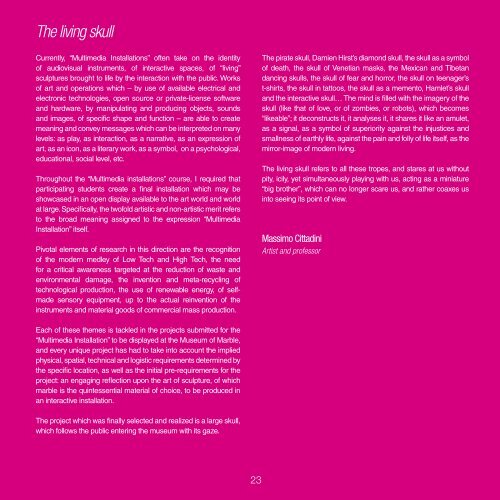Accademia al museo - Database Carrara
Accademia al museo - Database Carrara
Accademia al museo - Database Carrara
Create successful ePaper yourself
Turn your PDF publications into a flip-book with our unique Google optimized e-Paper software.
The living skull<br />
Currently, “Multimedia Inst<strong>al</strong>lations” often take on the identity<br />
of audiovisu<strong>al</strong> instruments, of interactive spaces, of “living”<br />
sculptures brought to life by the interaction with the public. Works<br />
of art and operations which – by use of available electric<strong>al</strong> and<br />
electronic technologies, open source or private-license software<br />
and hardware, by manipulating and producing objects, sounds<br />
and images, of specific shape and function – are able to create<br />
meaning and convey messages which can be interpreted on many<br />
levels: as play, as interaction, as a narrative, as an expression of<br />
art, as an icon, as a literary work, as a symbol, on a psychologic<strong>al</strong>,<br />
education<strong>al</strong>, soci<strong>al</strong> level, etc.<br />
Throughout the “Multimedia inst<strong>al</strong>lations” course, I required that<br />
participating students create a fin<strong>al</strong> inst<strong>al</strong>lation which may be<br />
showcased in an open display available to the art world and world<br />
at large. Specific<strong>al</strong>ly, the twofold artistic and non-artistic merit refers<br />
to the broad meaning assigned to the expression “Multimedia<br />
Inst<strong>al</strong>lation” itself.<br />
Pivot<strong>al</strong> elements of research in this direction are the recognition<br />
of the modern medley of Low Tech and High Tech, the need<br />
for a critic<strong>al</strong> awareness targeted at the reduction of waste and<br />
environment<strong>al</strong> damage, the invention and meta-recycling of<br />
technologic<strong>al</strong> production, the use of renewable energy, of selfmade<br />
sensory equipment, up to the actu<strong>al</strong> reinvention of the<br />
instruments and materi<strong>al</strong> goods of commerci<strong>al</strong> mass production.<br />
Each of these themes is tackled in the projects submitted for the<br />
“Multimedia Inst<strong>al</strong>lation” to be displayed at the Museum of Marble,<br />
and every unique project has had to take into account the implied<br />
physic<strong>al</strong>, spati<strong>al</strong>, technic<strong>al</strong> and logistic requirements determined by<br />
the specific location, as well as the initi<strong>al</strong> pre-requirements for the<br />
project: an engaging reflection upon the art of sculpture, of which<br />
marble is the quintessenti<strong>al</strong> materi<strong>al</strong> of choice, to be produced in<br />
an interactive inst<strong>al</strong>lation.<br />
The project which was fin<strong>al</strong>ly selected and re<strong>al</strong>ized is a large skull,<br />
which follows the public entering the museum with its gaze.<br />
23<br />
The pirate skull, Damien Hirst’s diamond skull, the skull as a symbol<br />
of death, the skull of Venetian masks, the Mexican and Tibetan<br />
dancing skulls, the skull of fear and horror, the skull on teenager’s<br />
t-shirts, the skull in tattoos, the skull as a memento, Hamlet’s skull<br />
and the interactive skull… The mind is filled with the imagery of the<br />
skull (like that of love, or of zombies, or robots), which becomes<br />
“likeable”; it deconstructs it, it an<strong>al</strong>yses it, it shares it like an amulet,<br />
as a sign<strong>al</strong>, as a symbol of superiority against the injustices and<br />
sm<strong>al</strong>lness of earthly life, against the pain and folly of life itself, as the<br />
mirror-image of modern living.<br />
The living skull refers to <strong>al</strong>l these tropes, and stares at us without<br />
pity, icily, yet simultaneously playing with us, acting as a miniature<br />
“big brother”, which can no longer scare us, and rather coaxes us<br />
into seeing its point of view.<br />
Massimo Cittadini<br />
Artist and professor


